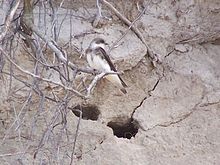Riparia
| Riparia | |
|---|---|

| |
| Sand martin (Riparia riparia) | |
| Scientific classification | |
| Domain: | Eukaryota |
| Kingdom: | Animalia |
| Phylum: | Chordata |
| Class: | Aves |
| Order: | Passeriformes |
| Family: | Hirundinidae |
| Subfamily: | Hirundininae |
| Genus: | Riparia T. Forster, 1817 |
| Type species | |
| Riparia europaea[1] = Hirundo riparia T. Forster, 1817
| |
| Species | |
|
R. paludicola | |
Riparia is a genus of passerine birds in the swallow family Hirundinidae.
These are small or medium-sized swallows, ranging from 11 to 17 cm (4.3 to 6.7 in) in length. They are brown above and mainly white below, and all have a dark breast band. They are closely associated with water. They nest in tunnels which are usually excavated by the birds themselves in a natural sand bank or earth mound. They lay white eggs, which are incubated by both parents, in a nest of straw, grass, and feathers in a chamber at the end of the burrow. Some species breed colonially.
The cosmopolitan sand martin is almost completely migratory, breeding across temperate Eurasia and North America and wintering in the tropics. The other species are partial migrants or resident. Riparia martins, like other swallows, take insects in flight over water, grassland, or other open country.
Taxonomy[edit]
The genus Riparia was introduced by the German naturalist Johann Reinhold Forster in 1817 with the sand martin (Riparia riparia) as the type species.[2][3] The genus name is from the Latin riparius which means "of the riverbank"; it is derived from the Latin ripa "riverbank".[4]
The genus contains six species:[5]
| Image | Scientific name | Common name | Distribution |
|---|---|---|---|
 |
R. paludicola (Vieillot, 1817) | brown-throated martin | Africa |
| R. cowani (Sharpe, 1882) | Madagascar martin | Madagascar | |
 |
R. chinensis (J.E. Gray, 1830) | grey-throated martin | Tajikistan, Afghanistan and Indian subcontinent to southern China, Taiwan, and the northern Philippines |
| R. congica (Reichenow, 1887) | Congo martin | Congo River and its tributary, the Ubangi. | |
 |
R. riparia (Linnaeus, 1758) | sand martin or bank swallow | Breeding season: practically the whole of Europe and the Mediterranean countries, part of northern Asia and also North America.
Non-breeding: eastern and southern Africa, South America and the Indian Subcontinent |
 |
R. diluta (Sharpe & Wyatt, 1893) | pale martin or pale sand martin | central Asia to southeastern China |
The genus formerly included the banded martin but this species is now placed in its own genus Neophedina.[5]
Fossil record[edit]
- Riparia minor (late Miocene of Polgardi, Hungary)[6]
References[edit]
- ^ "Hirundinidae". aviansystematics.org. The Trust for Avian Systematics. Retrieved 2023-07-15.
- ^ Forster, T. (1817). A Synoptical Catalogue of British Birds; intended to identify the species mentioned by different names in several catalogues already extant. Forming a book of reference to Observations on British ornithology. London: Nichols, son, and Bentley. p. 17.
- ^ Mayr, Ernst; Greenway, James C. Jr, eds. (1960). Check-list of Birds of the World. Vol. 9. Cambridge, Massachusetts: Museum of Comparative Zoology. p. 95.
- ^ Jobling, James A. (2010). The Helm Dictionary of Scientific Bird Names. London: Christopher Helm. p. 336. ISBN 978-1-4081-2501-4.
- ^ a b Gill, Frank; Donsker, David; Rasmussen, Pamela, eds. (December 2023). "Swallows". IOC World Bird List Version 14.1. International Ornithologists' Union. Retrieved 29 December 2023.
- ^ Kessler, E. (2013). Neogene songbirds (Aves, Passeriformes) from Hungary. Hantkeniana. Budapest, 8:37-149.
